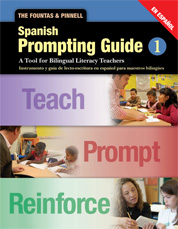Yesterday I talked about The Fountas and Pinnell Prompting Guide, and now I am going to talk about the Spanish edition and what it has to offer.
The Spanish version has explanatory text in English but provides the student prompting example dialogue in Spanish. Thus, the target audience is bilingual teachers, rather than monolingual Spanish teachers. This is also apparent when looking at the front covers and seeing the blend of languages on the Spanish cover. The tabs of both resources are exactly the same with writing in English for both versions. In addition, everything I loved about the crisp, clean lay-out of the English version, is also the same. Much of the introductory text is also the same in both versions, although there are some subtle differences appropriate to biliteracy in the Spanish edition.
Though not the main intended audience, the resource still has the potential to be a powerful resource for monolingual teachers, as well as a scaffold for Spanish speaking parents to become more involved in their children's literacy learning if schools provide sufficient background information to guide parents on how to utilize the tool.
The English and Spanish versions have much in common, but what stood out to me about Fountas and Pinnell resources provided in Spanish is that the authors don't just translate the English version to Spanish word for word. Instead, they make sure to consult with many native Spanish speakers to have high quality translations and they intentionally think about what is unique to biliteracy in comparison to literacy. For this specific resource they also have a statement in the introduction explaining the need for teachers utilizing the guide to be cognizant of regional variations of Spanish and the vocabulary that students will understand. Yet, they took it a step further by providing lexical variations in parenthesis throughout helping to raise the level of awareness for teachers while using the guide. I appreciate that they did not choose to just go by one variation of Spanish but instead took the time to really think about what would be most beneficial to students as individuals.
In my position at a dual immersion school, I teach in both languages, as does the kindergarten teacher. However, the rest of the Spanish immersion teachers only teach in Spanish, as they have a teaching partner that does the English side of the immersion. While Spanish immersion teachers would be able to take high quality resources in English that are relevant to Spanish and translate them (and often need to do so), it is so nice to find high quality resources already translated for bilingual teachers. It can often be draining teaching solely in Spanish in the United States, when there is such a disparity between resources in Spanish vs. resources in English. Thus, even though teachers could have taken the English version of the prompting guide as a scaffold for Spanish literacy instruction, I am grateful that the authors and Heinemann took the time to provide bilingual teachers will a little bit more support, especially since they are not just providing a word for word translation. I am excited to share this resource with teachers at my school.
Copy provided by the publisher


No comments:
Post a Comment